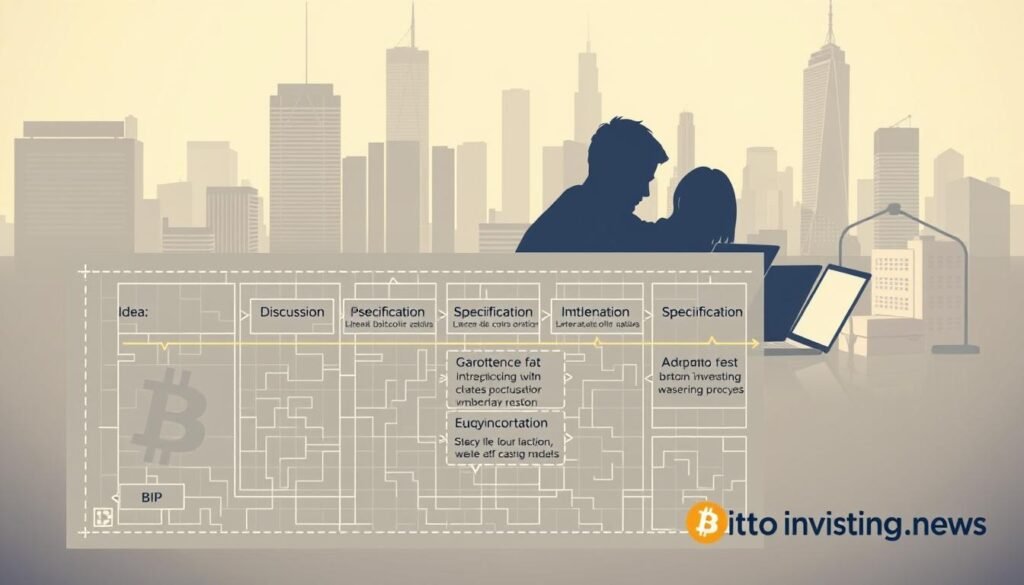What is a Bitcoin Improvement Proposal (BIP)?
The Bitcoin world is always changing. More than 200 Bitcoin Improvement Proposals (BIPs) have been made.
A BIP is a plan to make Bitcoin better. It’s key to how Bitcoin is run.
The BIP way lets everyone help make Bitcoin better. This keeps Bitcoin open and fair.
Key Takeaways
- A BIP is a formal proposal to change or improve Bitcoin.
- BIPs play a big role in how Bitcoin is run.
- The BIP process lets everyone help decide what’s best for Bitcoin.
- BIPs help keep Bitcoin open and fair.
- Over 200 BIPs have been made for Bitcoin.
What is a Bitcoin Improvement Proposal (BIP)?
The BIP process is key to Bitcoin’s growth. It lets the community make software better. This is how Bitcoin stays open and free.
Definition and Core Concept
A BIP is a plan for making Bitcoin better. It can be a new idea or a way to fix something. BIPs are easy to read and understand.
Anyone can suggest a BIP. This means lots of ideas get a chance. It’s a way for everyone to work together on Bitcoin.
The Role of BIPs in Bitcoin’s Ecosystem
BIPs are vital for making Bitcoin better. They help with updates and keeping the network safe. This is how Bitcoin grows and stays strong.
| Role of BIPs | Description |
|---|---|
| Proposing Changes | BIPs let people suggest new things for Bitcoin. This can make it faster, safer, and easier to use. |
| Facilitating Discussion | BIPs help everyone talk about ideas. This makes sure ideas are good before they happen. |
| Standardizing Improvements | BIPs make sure changes are done the same way. This keeps Bitcoin consistent and reliable. |
The BIP process is key to Bitcoin’s future. It lets the community work together to make Bitcoin better.
The Purpose and Importance of BIPs
BIPs are very important in the Bitcoin world. They help Bitcoin grow and stay strong. Changes are made in a way that everyone agrees on.
Standardizing Protocol Changes
BIPs make sure changes to Bitcoin are done right. They talk about, check, and test changes before they happen. This stops sudden changes that could mess things up.
With BIPs, Bitcoin stays safe and steady. A big group of people, including developers and users, review and agree on changes.
Facilitating Technical Communication
BIPs help people talk about technical stuff. They make it easy to share and discuss new ideas for Bitcoin. This way, everyone can work together to make Bitcoin better.
It’s a team effort. Ideas get better and better, making Bitcoin stronger.
Preserving Bitcoin’s Decentralized Nature
The BIP process keeps Bitcoin free from control. It lets the community help decide what changes to make. This way, no one person can change Bitcoin alone.
It keeps Bitcoin’s way of working fair and open. This makes everyone feel like they’re part of something big and important.
History and Evolution of Bitcoin Improvement Proposals
The BIPs show how the Bitcoin community keeps getting better. The first BIP was made by Amir Taaki on August 19, 2011. Ever after, BIPs have changed a lot, helping shape Bitcoin’s future.
Origins of the BIP System
The BIP system was made to help change the Bitcoin protocol in a good way. The first BIP explained what a BIP is. It was key for a clear and team effort in making changes.
Experts say the BIP system helps a lot with bitcoin development. It keeps the community working together towards the project’s goals.
Key Milestones in BIP Development
There have been many important moments in BIP history. BIP 16 and BIP 17 were big because they changed the Bitcoin protocol. BIP 141, which brought Segregated Witness (SegWit), made Bitcoin better for everyone.
| BIP | Description | Year |
|---|---|---|
| BIP 16 | Pay-to-Script-Hash (P2SH) | 2012 |
| BIP 141 | Segregated Witness (SegWit) | 2016 |
| BIP 340 | Taproot | 2020 |
How the BIP Process Has Matured
The BIP process has grown a lot. It’s now a big part of Bitcoin’s bip governance. The community has made a strong way to suggest, check, and add new things to the protocol. This shows in how smart BIPs are and how well they are checked.
“The BIP process has become a cornerstone of Bitcoin’s development, enabling the community to collaborate on and implement significant improvements to the protocol.”
The bip updates have made Bitcoin’s blockchain technology better. They help keep Bitcoin safe and useful for everyone.
The BIP Process: From Idea to Implementation
Turning an idea into a BIP takes many steps. It makes sure changes to Bitcoin are checked and liked by everyone.
Drafting a Proposal
The first step is writing a proposal. Authors need to explain the change, why it’s needed, and how it will affect Bitcoin. A good BIP is clear and detailed, so everyone can understand it.
Review and Discussion
After a BIP is written, it’s reviewed by the Bitcoin community. This is key for finding problems and getting support. As Bitcoin Core developer Greg Maxwell said, “The BIP process helps us talk things through and agree on changes.”
“The BIP process is open and lets everyone join in the discussion.”
Acceptance Criteria
A BIP must meet certain rules to be accepted. It needs to work well technically, fit with Bitcoin’s goals, and have lots of support. The rules for acceptance are strict to make sure only good changes happen.
Implementation and Activation
When a BIP is accepted, developers start working on it. They write the code and get ready for it to be used. It needs a yes from most nodes and miners to be used by all.

The BIP process shows how Bitcoin is governed by everyone. It lets Bitcoin keep getting better while staying strong. Thanks to this, Bitcoin can grow and meet its users’ needs.
Types of Bitcoin Improvement Proposals
It’s important to know about the different BIPs. They help the Bitcoin network grow. The Bitcoin community uses BIPs to suggest, talk about, and make changes to the protocol. These changes are grouped by their purpose and how they affect things.
Standard BIPs
Standard BIPs suggest changes to the Bitcoin protocol. This includes updates to the rules or important parts of the network. These changes help keep Bitcoin working well and safe.
Key characteristics of Standard BIPs include:
- They change the Bitcoin protocol or rules.
- They need a lot of talk and checking.
- They might need a soft or hard fork to be made.
Informational BIPs
Informational BIPs share info or guidelines but don’t change the protocol. They help with using Bitcoin’s features right, explain why certain decisions were made, or talk about future improvements.
Informational BIPs are valuable because they:
- Give tips on using Bitcoin’s features well.
- Help understand the reasons behind some decisions.
- Start discussions on possible future upgrades.
Process BIPs
Process BIPs suggest changes to how BIPs are made, checked, and put into action. These changes are key to keeping the BIP process healthy and working well. They help the community adapt and get better at proposing and making changes.
A famous Bitcoin developer said, “Process BIPs are key for the BIP process to grow. They let the community change and get better at proposing and making changes.”
“The BIP process is not static; it evolves based on the needs and experiences of the Bitcoin community.”
Knowing about these three BIP types shows how flexible and complex the BIP process is. It’s made to meet different needs and improve the Bitcoin world.
Notable BIPs That Shaped Bitcoin
Many important BIPs have changed Bitcoin a lot. They made it better at handling lots of transactions, safer, and more useful. These changes have made Bitcoin stronger and more useful for people.
SegWit (BIP141)
Segregated Witness, or SegWit, is a big deal. It fixed a problem with transactions and let more happen at once. This bitcoin protocol enhancement made the network faster and better.
Lightning Network (BIPs112,114,125)
The Lightning Network is another big step. It makes transactions quicker and cheaper. This blockchain upgrade makes Bitcoin better for everyday use.
Taproot (BIPs340,341,342)
Taproot is a big update. It makes Bitcoin more private and efficient. This cryptocurrency update has made Bitcoin more useful and easy to use.
Other Influential BIPs
Other BIPs have also helped Bitcoin grow. For example, BIP32 made wallets easier to manage. BIP65 added a new way to script transactions, making Bitcoin even more powerful.
The bip implementation of these ideas has made Bitcoin what it is today. As Bitcoin keeps growing, new ideas will help it get even better.
BIP Governance and Decision-Making
Understanding how BIPs work is key to seeing Bitcoin grow. The BIP process is all about being open and fair. It uses many ways to keep Bitcoin’s growth honest and true.
The Role of Bitcoin Core Developers
Bitcoin Core developers are very important. They check, talk about, and make BIPs happen. Their skills help figure out if changes are good and work well.
Key Responsibilities of Bitcoin Core Developers:
- They check BIP proposals to see if they are good and fit.
- They talk and debate BIPs on places like GitHub and mailing lists.
- They add accepted BIPs to the Bitcoin Core software.
Community Consensus Mechanisms
The BIP process needs everyone to agree. This happens through emails, forums, and social media. Everyone’s thoughts help shape Bitcoin’s future.
Community consensus is achieved through:
- Open talks on BIP proposals.
- Showing support or not through different ways.
- Helping test and check BIPs.
Resolving Conflicts and Disagreements
It’s normal for disagreements to happen. The BIP process has ways to fix these. It uses talks, finding common ground, and sometimes new ideas.
| Conflict Resolution Mechanism | Description |
|---|---|
| Mediated Discussions | Neutral people help talks to find agreement |
| Compromise | Everyone finds a middle way that works for all |
| Alternative Proposals | New ideas are made to fix problems and worries |
The way BIPs are governed shows Bitcoin’s true nature. It mixes the skills of core developers with the views of the community. This makes sure Bitcoin grows in a smart and fair way.
The BIP Activation Process
Learning about the BIP activation process helps us see how Bitcoin grows. It adds new features and gets better over time. This process involves many people and technical steps to make changes smoothly.
Miner Signaling and Voting
Miners are key in the BIP activation process. They show support for new BIPs by including special data in their blocks. This shows how many miners back the change.
Miners vote by adding certain data to their blocks. They show if they support or don’t support the BIP. A lot of support is needed for the BIP to move forward.

Node Adoption Requirements
Getting nodes to adopt new changes is important. Nodes check and share transactions on the Bitcoin network. For a BIP to work, many nodes must update to the new version.
Node operators must update their software manually. How many nodes update is key. It helps the network follow the new rules.
Soft Forks vs. Hard Forks
Understanding soft forks and hard forks is key. A soft fork is a change that doesn’t break older versions. Nodes that haven’t updated can keep working, but they won’t follow the new rules.
A hard fork, on the other hand, is a big change. It needs all nodes to update to work on the new network.
| Characteristics | Soft Fork | Hard Fork |
|---|---|---|
| Backward Compatibility | Yes | No |
| Node Upgrade Requirement | No | Yes |
| Network Impact | Minimal disruption | Potential for significant disruption if not widely adopted |
Challenges in BIP Implementation
BIP implementation faces many challenges. These include technical obstacles, getting everyone to agree, and keeping things working as they are. Updating the Bitcoin protocol through BIPs is very complex.
Technical Hurdles
One big challenge is the technical side. It’s important to make sure new changes work well with what we already have. Developers must test and simulate to find and fix problems before they start.
Some BIPs, like SegWit (BIP141), need big changes. These changes need a deep understanding of the Bitcoin code. They also affect how the network works.
Achieving Network-Wide Adoption
Getting everyone to agree is another big challenge. For a BIP to work, most nodes and miners must support it. This needs good communication and teamwork among developers, miners, and node operators.
The way we activate BIPs, like through miner voting, is key. But, this can be slow and hard if people disagree about a BIP.
Backward Compatibility Concerns
Keeping things compatible is also a big worry. Changes must work with what we already have. Backward compatibility lets older software and infrastructure keep working, even if they miss out on new stuff.
BIPs that add new features or big changes need careful planning. They must not split the network or cause trouble for users. This means understanding how different parts of Bitcoin work together.
BIPs Compared to Other Cryptocurrency Improvement Processes
BIPs make Bitcoin special in the world of cryptocurrencies. Other blockchain platforms have their own ways to improve. But Bitcoin’s BIPs are unique.
Ethereum Improvement Proposals (EIPs)
Ethereum’s EIPs are similar to BIPs but different too. Both help add new features or changes. But Ethereum moves faster in making changes.
Ethereum’s rules are made by its developers and the Ethereum Foundation. Bitcoin’s BIPs need a wide agreement from many people.
| Feature | BIPs | EIPs |
|---|---|---|
| Governance Model | Decentralized, broad consensus | More centralized, influenced by core developers and Ethereum Foundation |
| Proposal Process | Formal, rigorous review | Flexible, dynamic |
| Innovation Pace | Conservative, prioritizing stability | Faster, more adaptable to change |
Other Blockchain Governance Models
Other blockchains have different ways to make decisions. Some are more centralized. Others are more like Bitcoin.
“The governance structure of a blockchain is key to its success. It affects how it can change and grow.”
What Makes Bitcoin’s Process Unique
Bitcoin’s BIPs focus on decentralization and broad consensus. This makes sure changes are safe and accepted by many. It keeps the network strong and secure.
To learn more about Bitcoin’s BIPs, visit https://river.com/learn/what-is-a-bitcoin-improvement-proposal-bip/.
Conclusion
The Bitcoin Improvement Proposal (BIP) is key to Bitcoin’s growth. It lets the community help shape Bitcoin’s future. This teamwork has helped Bitcoin grow and get more popular.
With BIPs, developers and others can suggest and make changes to Bitcoin. This makes Bitcoin’s development open and community-led. As blockchain tech grows, BIPs help Bitcoin stay ahead.
BIPs help Bitcoin talk better and make changes smoothly. They’ve been very important for Bitcoin’s success. As Bitcoin gets better, BIPs will keep helping it grow and improve.
FAQ
What is a Bitcoin Improvement Proposal (BIP)?
A Bitcoin Improvement Proposal (BIP) is a plan to change or improve Bitcoin. It lets the community help decide on changes.
What is the purpose of a BIP?
BIPs help standardize changes to Bitcoin. They make sure changes are open and fair. This keeps Bitcoin decentralized.
What are the different types of BIPs?
There are three types of BIPs. Standard BIPs, Informational BIPs, and Process BIPs. Each has its own role in Bitcoin.
How are BIPs implemented and activated?
BIPs go through a few steps. First, a proposal is written. Then, it’s reviewed and discussed. Changes are made with the community’s agreement.
What is the role of Bitcoin Core developers in the BIP process?
Bitcoin Core developers are key in BIPs. They check and apply BIPs. They make sure changes fit with Bitcoin’s rules.
How are conflicts and disagreements resolved in the BIP process?
Conflicts are solved by the community. This keeps the BIP process open and fair.
What is the difference between a soft fork and a hard fork in the context of BIPs?
A soft fork is a change that doesn’t break Bitcoin. A hard fork changes Bitcoin in a big way. Soft forks are less disruptive.
What are some notable BIPs that have shaped the Bitcoin network?
Some key BIPs are SegWit, Lightning Network, and Taproot. They’ve made Bitcoin better and more useful.
How does the BIP process compare to other cryptocurrency improvement processes?
The BIP process is unique. It’s different from Ethereum’s EIP process. Each has its own way of making changes.
What are some challenges associated with implementing BIPs?
BIPs face technical challenges and getting everyone to agree. They also need to work with old versions of Bitcoin. Updating Bitcoin is complex.


